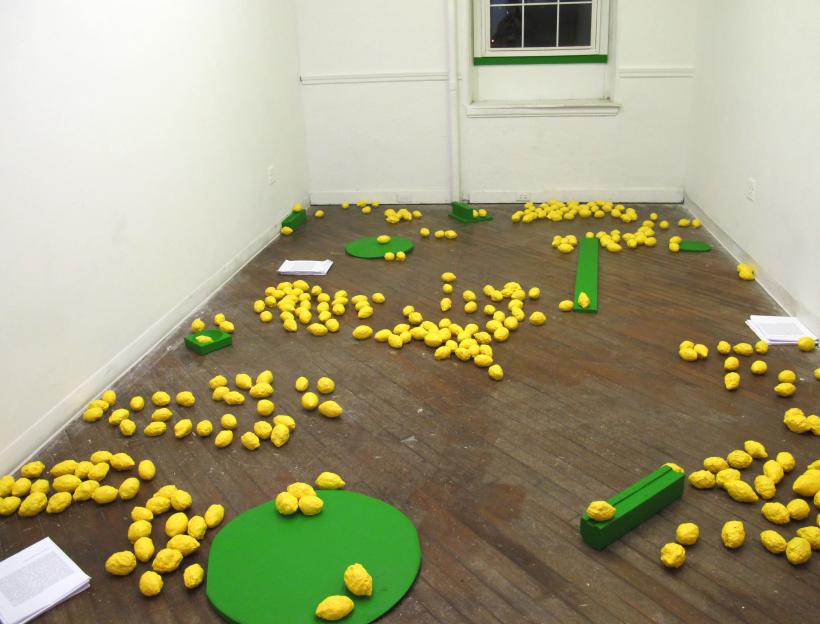There are several layers to Lydia Rosenberg’s highly conceptual, experimental exhibition ‘The Complete Subject’, currently on view at Napoleon, each relying upon people’s individual perceptions of meaning. What you get out of ‘The Complete Subject’ absolutely depends on your tolerance for this kind of self-perpetuating thought experiment. Occasionally frustrating and potentially a little too self-referential, ‘The Complete Subject’ nonetheless rewards thoughtful consideration and a willingness to delve into recursive, philosophy-seminar-esque ideas about seeing, translating, and understanding.
The installation itself is deceptively simple, which suits the complex layers of thought and perception it conjures. Rosenberg has crafted several hundred lemons of varying degrees of accuracy, using materials that include clay, cement, wax, wood, pulp, and others, and strewn them with no particular rhyme or reason across the rough, unfinished planks of the gallery floor. Breaking up the potential monotony of all that pale, bright-yellow are numerous geometric forms painted a pure, colour-wheel green, occasionally touching or set against the lemons: a flat, foot-long rectangle, and a circle the size and thickness of a dinner plate. The final touches are stacks of staple-bound white sheets comprising Rosenberg’s accompanying ongoing novel, ‘The Complete Subject’, which gives some context to what all these lemons are doing here.
In Rosenberg’s narrative, a character named Joanne obsessively goes about chronicling every lemon she can find in paintings, writing about them in short diary entries that purposefully do not recount the specific painting or artist—merely her impression of each lemon. The entries, printed in the same green as the various props on the floor, are, according to the artist, each written by a different woman she knows about a non-specific lemon. This aspect of ‘The Complete Subject’, along with the overall story, is also in process. It’s as if the lemons in the diary entries have crossed the boundary between the two- and three-dimensional and have spilled out, unbidden, from the page into the physical world, littering the floor like they’ve escaped an overturned fruit cart. The traces of female obsession, the context of literature, the form of journal entries, and the unmistakable hues of yellow naturally bring to mind Charlotte Perkins Gilman’s novel ‘The Yellow Wallpaper’, giving the show an air of desperation despite the apparently casual nature of its presentation.
Yet it’s important to note that there’s no direct correlation between the lemons in the paintings Joanne sees, the lemons in the diary entries, and the lemon-sculptures that exist in the gallery space, highlighting the multiplicity of perspectives that are present even if people are looking at the exact same thing. The highly-realistic cement lemon sculptures on the floor don’t correspond to a Dutch Golden Age painting, while a soft, vaguely oblong lemon form made of a pulpy material doesn’t correspond to an abstract painting of a lemon. Indeed, a good number of the works on display are so abstract they would not even translate into the idea of “lemons” were they not painted yellow, slightly oval-shaped, and placed in the context of more naturalistically depicted lemons. Other objects in ‘The Complete Subject’ recall not lemons, but more warty, less perfectly-oval etrogs, combined with bright green elements that reference the Jewish holiday of Sukkot.
This leap of association is partially the point. Essentially, Rosenberg argues, it’s not that a singular lemon changes form in transitioning from raw fruit to painting to written description, but becomes an entirely different lemon altogether. Even if you and I are looking at a single lemon, we do not actually see the same lemon, but instead different lemons (or etrogs, or other forms) that are informed by our own histories or vision of a singular platonic ideal of a lemon. The gaps in our different understandings of the world, or the failures of depiction and/or description as rendered by the different women who are all “Joanne”, mean that each lemon is simultaneously multiple lemons—a potentially infinite number of lemons, depending on how many of people are there to compare it to their own preconceived images of lemons, born both of expectation and experience.







